Wondering how to replace shingles on your roof? This comprehensive guide will walk you through the step-by-step process of replacing damaged shingles on your roof. Following these instructions makes sure that your roof is in good condition and provides a safe and dry environment for your home and family.
Quick Guide: Fixing Shingles on Your Roof
Before diving into the old shingles replacement process, it’s essential to understand why replacing damaged shingles is crucial for the overall health of your roof.
Damaged shingles can lead to various issues, including:
- Water Damage: Damaged shingles can allow water to seep into your roof, leading to moisture buildup and potential leaks.
- Structural Damage: If left unaddressed, water damage caused by damaged shingles can weaken the underlying structure of your roof, compromising its stability.
- Mold and Mildew Growth: Moisture from leaks can create an environment conducive to mold and mildew growth, posing health risks and further damaging your roof.
- Energy Inefficiency: Damaged shingles can compromise the insulation of your roof, resulting in increased energy consumption and higher utility bills.Always check the manufacturer’s recommendations before applying chemicals to your metal roof.
By promptly replacing damaged shingles, you can prevent these issues and ensure the long-term durability of your roof.
Basic Roof Shingle Replacement Tools & Equipment
Here’s what you’ll need if you’re going to replace damaged asphalt shingles with new shingles:
- Protective Gear: Prioritize safety by wearing protective eyewear, heavy-duty gloves, and gripping boots suitable for walking on the roof.
- Ladder and Safety Equipment: Use a secure and sturdy ladder to access the roof. Consider installing roof jacks and harnesses for added safety.
- Replacement Shingles: Purchase replacement shingles that match the style and color of your existing roof. Buy extra shingles to account for any future repairs.
- Shingle Adhesive or Cement: Depending on the shingle type, you may need adhesive or cement to secure the replacement shingles.
- Roofing Nails: Use roofing nails that are appropriate in length and strength for securing the shingles.
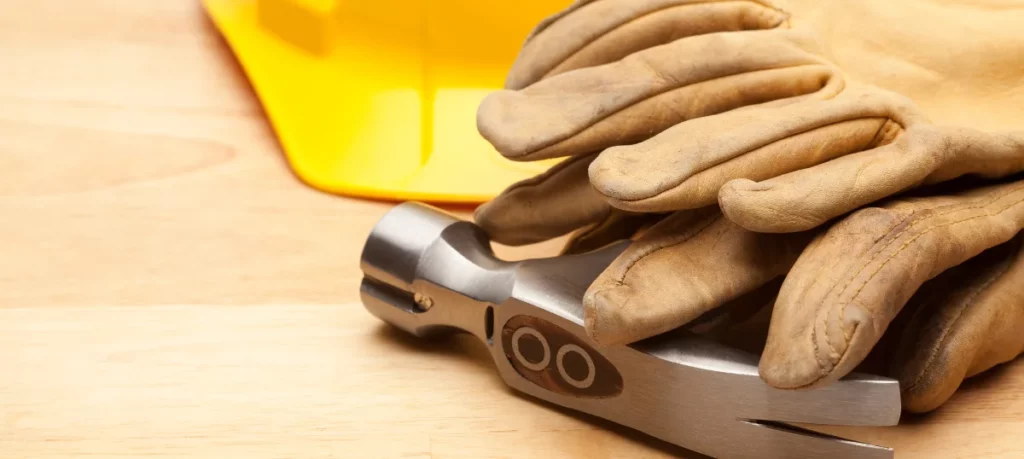
Having all the necessary tools and materials ready can streamline the replacement process and ensure a successful outcome.
Easy Solution for Patching Roof Shingles: Assess The Damage First
Most homeowners will skip this step and assume they need to fix the damaged portion — not so fast, it’s crucial to assess the extent of the damage and identify other areas that require repair.
Follow these steps to assess the damage:
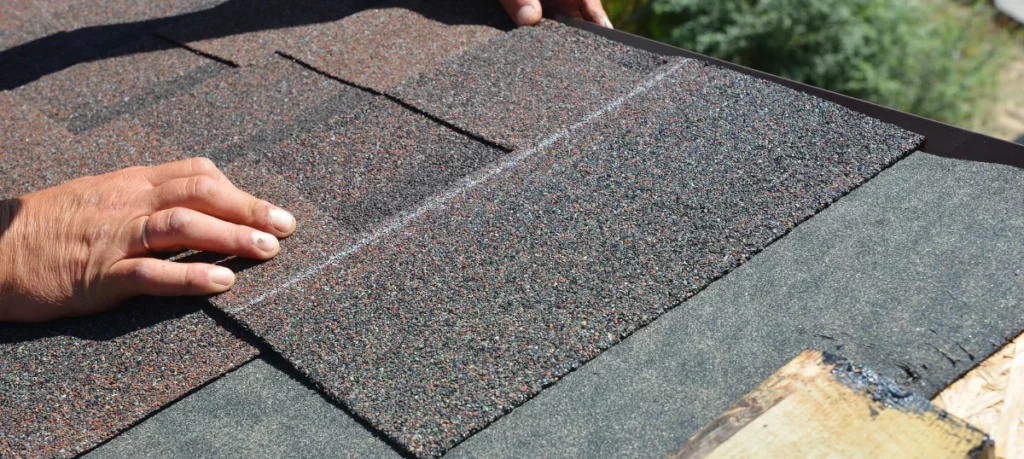
- Visual Inspection: Carefully inspect your roof for any signs of damaged shingles. Look for curled, cracked, or missing shingles and signs of water damage or leaks.
- Check Surrounding Shingles: Examine the shingles surrounding the damaged area. Pay attention to any curling or lifting at the corners, which may indicate underlying damage.
- Evaluate Moisture Barrier and Flashing: Check the moisture barrier and flashing in the damaged area for any signs of damage or deterioration. Addressing these issues is essential to prevent future leaks.
- Consider Overall Roof Condition: Assess the overall condition of your roof. If the surrounding shingles are old, brittle, and dry, re-roofing the entire area may be more cost-effective than replacing individual shingles.
Remove Damaged Shingles: Simple Steps for Roof Shingle Repair
Now that you have assessed the damage and identified the areas that require repair, it’s time to remove the damaged shingles.
Follow these steps to ensure a safe and effective removal process:
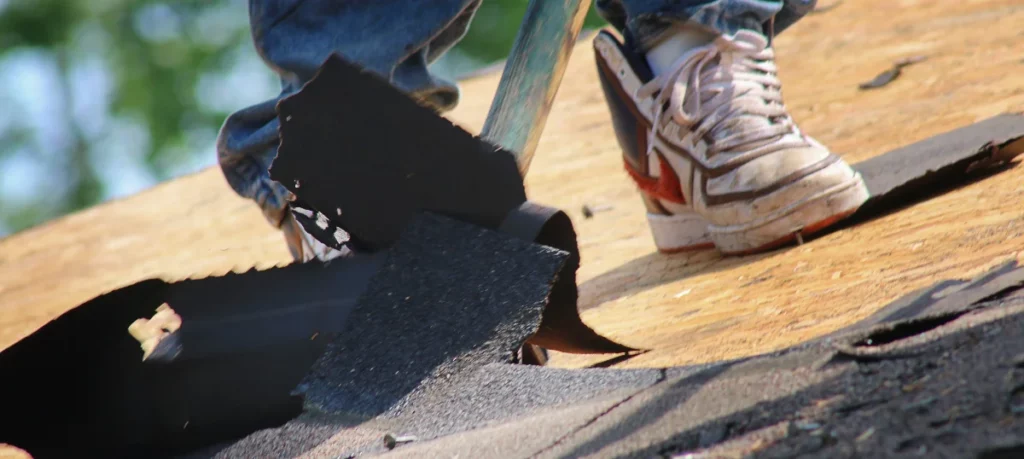
- Safety Precautions: Prioritize safety by practising proper roof safety measures. Wear protective gear, secure your ladder, and work with a partner whenever possible.
- Cool Weather Removal: Choose a cool day to remove the shingles, as asphalt and sealant are more pliable and easier to remove in cooler temperatures. If working in hot weather, wetting the shingles can help cool them down and make them more manageable.
- Breaking the Adhesive Bond: Use a pry bar or a hammer claw to carefully loosen the adhesive bond between the damaged shingle and the roof. Start by lifting the corners and gradually work your way towards the center.
- Removing Nails: Once the adhesive bond is broken, remove the four nails securing the damaged shingle. Slide the pry bar under the shingle and lift it to expose the nails. Carefully pry the nails upward to remove them from the roof deck.
- Removing Adjacent Nails: In some cases, nails from the shingles above the damaged area may penetrate the upper edge of the damaged shingle. Repeat the adhesive bond-breaking step on the asphalt shingles two courses above the damaged area and remove the nails from the shingles in the course immediately above.
- Complete Shingle Removal: Once all the nails are removed, gently lift and remove the damaged shingle. Be cautious not to damage surrounding asphalt shingles during the removal process.
Essential Tips for Shingle Roof Repair: The Installation Process
With the damaged shingles removed, it’s time to install the replacement shingles. Here’s how to ensure proper installation:
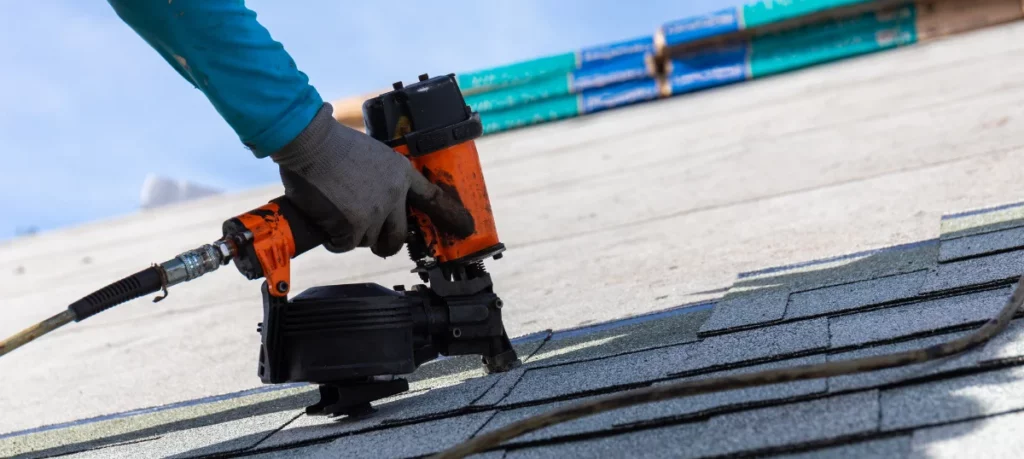
- Gather Replacement Shingles: Take out the replacement shingles you purchased, ensuring they match the style, color, and size of your existing shingles.
- Positioning the Shingle: Place the replacement shingle in the same position as the one you removed. Align it with the surrounding shingles to maintain a consistent appearance.
- Securing the Shingle: Use adhesive or cement to secure the replacement shingle in place depending on the shingle type. Follow the manufacturer’s instructions for the specific adhesive or cement you are using.
- Nailing the Shingle: Once it is secured with adhesive, use roofing nails to secure it further. Place nails in the designated nail slots or pre-cut holes, ensuring they penetrate the replacement shingle and the underlying roof deck.
- Repeating the Process: Continue installing and securing the replacement shingles, working your way up and across the damaged area. Ensure each shingle is properly aligned and secured before moving on to the next one.
Efficient Ways to Patch a Shingle Roof: Repair Cracked or Split Shingles
It’s possible to repair cracked or split shingles without removing them entirely. If that’s the case, here’s the most efficient way to do so:
- Identifying Cracked or Split Shingles: Inspect your roof for any cracked or split shingles. These shingles can often be repaired without complete removal, just by patching them with some sealant.
- Applying Roofing Sealant: Use a roofing sealant or adhesive to repair the cracked or split shingles. Apply a thick bead of sealant along the crack or split, ensuring it fills the entire length of the damaged area.
- Pressing Shingles Together: Press the cracked or split shingles together to seal the adhesive or sealant. Hold them in place for several seconds to ensure a secure bond.
- Camouflaging the Repair: Check the gutters for colored granules that have washed down from the damaged shingles. Collect some of these granules and sprinkle them over the sealant to camouflage the repair and blend it with the surrounding shingles.
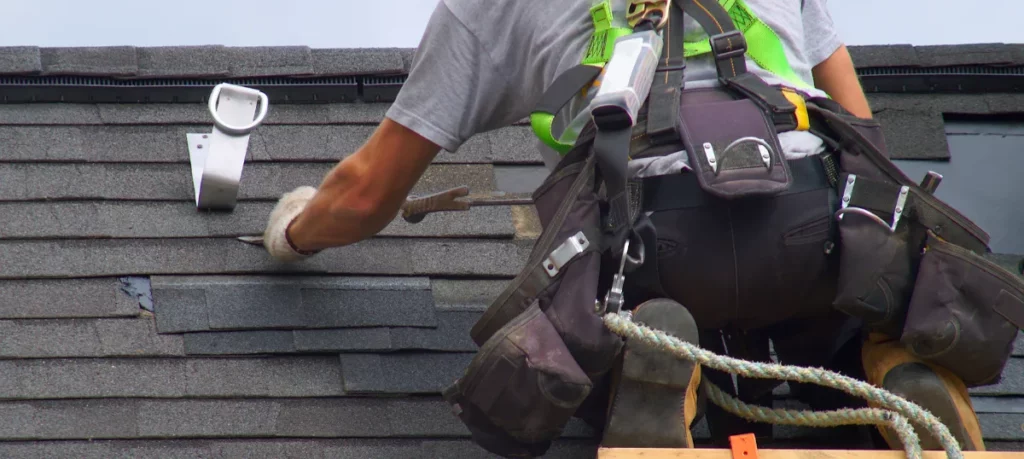
Shingle Fixed: Be Sure To Perform Regular Maintenance and Prevention
Maintaining the condition of your roof is essential for its long-term durability and performance. Here are some tips to help you prevent damage and prolong the lifespan of your shingles:
Regular Inspections:
Perform regular inspections to identify any signs of damage or wear. Look for curled, cracked, or missing shingles and signs of water damage or leaks.
Clearing Debris:
Keep your roof clear of debris, such as leaves, branches, and dirt. Regularly clean your gutters and downspouts to ensure proper water flow and prevent clogs.
Addressing Moss and Algae:
If you notice moss or algae growth on your roof, remove it promptly. Use appropriate cleaning solutions and techniques to prevent further damage.
Trimming Overhanging Branches:
Trim any tree branches that overhang your roof. Falling branches can cause significant damage to your shingles, so proactive trimming is essential.
Professional Inspections:
Schedule regular professional roof inspections to identify any hidden issues or potential problems. Professional roofers can provide expert advice and guidance on maintaining your roof’s condition.
Still Confused On How To Replace Shingles On A Roof? Seek Professional Roofing Help
While replacing damaged roof shingles is a task that can often be tackled by homeowners, there may be situations where professional help is necessary.
- Extensive Damage: If a large portion of your roof is damaged or requires replacement, it’s best to consult a professional roofer. They can assess the overall condition of your roof and provide comprehensive repair or replacement solutions.
- Safety Concerns: If you feel uncomfortable or unsafe working on your roof, hiring a roofing company with the necessary expertise and safety equipment is advisable.
- Warranty Considerations: If your roof is still under warranty, hiring a professional roofer to perform repairs or replacements can help ensure the warranty remains valid.
Conclusion
Following this step-by-step guide, you can confidently replace damaged shingles on your roof and maintain its overall health and durability.
Regular inspections, prompt repairs, and proactive maintenance are key to preventing further damage and prolonging the lifespan of your roof. Remember to prioritize safety, gather the necessary tools and materials, and seek professional help when needed.
With proper care and attention, your roof will continue to provide a safe and secure environment for your home and family for years to come.
Now that you have a comprehensive understanding of how to replace damaged shingles, it’s time to put this knowledge into action and ensure the long-term integrity of your roof. However, should you need assistance, contact a licensed roofing contractor like the Oaks Roofing and Siding team.
